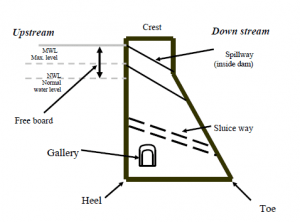A dam is a hydraulic structure constructed across a river, or stream to obstruct the flow of water through it. This impediment to flowing water helps in ponding or raising the water level upstream of the massive structure, leading to water accumulation or storage. The stored water can then be used for irrigation purposes, hydropower generation, drinking water supplies, flood control, etc.
The water stock created upstream of the constructed dam is termed as reservoir. A reservoir stores and distributes water for the intended operations. The type of dam structure to be built largely depends on the site conditions and topography. In addition, it is of practical importance to consider the geotechnical suitability of the site, the hydrologic adequacy of the river, its sedimentation possibilities as well as the feasibility of constructing a diversion structure for the river till the designed dam is materialized.
It is to be noted that the construction of a dam is a protractive process, and requires a humungous quantity of material. Therefore, the cost requisite also hikes up with a surge in the construction operations carried out at the site.
Hence, neglecting the knowledge of the availability of construction material and skilled labor, earthquake considerations, the valley shape, and overburden is a daft attempt of putting on the ground such a massive structure of paramount importance. It is imperative to consider the site conditions, environmental and economic constraints as well as geological and hydrological design parameters.
Table of Contents
Advantages of Constructing a Dam
Although the construction of a dam takes a great deal of time, money, and labor, the structure proves extremely fructuous in storing a large quantity of water that may be used for the following purposes:
- Irrigation
- Flood control
- Hydropower generation
- Recreational opportunities
- Navigation
- Industrial and domestic water supply
- Greater habitat diversity
Source: International Commission on Large Dams (ICOLD)
Types of Dams
A)Based on Material of Construction
Dams can be broadly put into two categories depending upon the material used for construction. These include,
1)Embankment Dams
These dams are made up of natural earth material that can be obtained near the vicinity of the dam site. Such dams have large cross-sections and the natural earth material is placed in a number of layers, each compacted properly. The face angles at the upstream and downstream sides are moderate, thereby resulting in a wide section entailing a large volume.
Embankment dams account for 85-90 percent of world dams. This is owing to some economical and technical reasons. They can further be classified into the following two types,
Earth-fill or Earthen Embankments:
In these dams, the bulk of the cross-section is constructed using natural soil. However, the engineering properties of the soil are determined and checked prior to the usage in construction. The soil is placed in very thin layers that are compacted uniformly at a controlled moisture content.
Earthen dams may have a clay core that provides better resistance to seepage. In addition, the cross-section may vary and zoning may also be provided. The following figure shows the different types of cross-sections of an earthen embankment.
Fig.: Principal types of earthen embankment dams
- Homogeneous with toe drain
- Homogeneous with chimney drain and horizontal blanket
- Zoned with clay core chimney drain and horizontal blanket
- Zoned with earth and rockfill
Example: Mangla dam constructed on river Jhelum is an earth-fill dam.
Rockfill Embankments:
In this type of dam, the bulk of the dam body is made up of gravels, crushed rocks, or boulders. However, the core is made impervious by using compacted earthfill or concrete.
The necessity of keeping the core impervious is that the shell of a rockfill dam invites water ingression and is permeable.
Therefore, the core blocks the water penetration. The dam attains its stability through inter-particle frictional forces that prevent sliding failure. The cross-section variation that may exist in the case of a rockfill dam is given in the adjoining picture.
Fig.: Principal types of rockfill embankment dams
- Vertical clay core and drains
- Inclined clay core and drains
- Upstream decked with asphaltic or concrete membrane and drains
- Central asphaltic membrane with drains
Example: Tarbela dam constructed on river Indus is earth and rockfill dam.
Advantages of Embankment Dams
- Be it steep gorges or wide valleys, embankment dams are good to go with for river valleys of all kinds.
- Since the dam has a broad base, it can adapt to a range of foundation conditions, inclusive of a permeable foundation.
- It uses natural earth material which can be obtained easily.
- It is relatively less costly.
Disadvantages of Embankment Dams
- Embankment dams are susceptible to getting washed away during an overtopping of a spillway, which may occur in case of flash flooding in the river followed by a delay in the opening of the gates of the spillway, or in case the spillway is of inadequate capacity.
- The spillway is to be accommodated somewhere outside the dam body.
- Any faulty construction may create a slew of issues from concealed leakage to erosion of the dam body
2)Concrete Dams
A concrete dam is essentially made up of concrete. The slopes at the upstream and downstream ends are usually different. The upstream end is less steep or nearly vertical whereas the downstream end has a steeper slope. The cross-section is slender, unlike an embankment dam.
Fig.: Typical cross-section of a concrete dam
Concrete dams, too, can have a variety in their cross-sections. The main types are enlisted and explained below:
Gravity Dam:
It is a concrete dam that withstands horizontal hydrostatic pressure by its weight. The stability of such a dam is to be analyzed for overturning and sliding, and the material stresses are to be checked against the compressive and tensile strengths.
Example: Warsak dam constructed on Kabul River is a gravity dam.
Arch Dam:
As the name indicates, an arch dam utilizes the arch action to resist the loading. The arch shape can exist in plan only or both in plan and section. The latter case is termed a cupola or double arch and is an efficient hydraulic structure in terms of its strength. However, the necessity of a very good foundation makes the dam structure site-specific.
Example: Gordon dam built on Gordon River in Australia is a double arch concrete dam.
Buttress Dam:
It consists of a series of supports or buttresses on the downstream side that hold the dam body. The upstream end can be either curved or flat.
Example: Coolidge dam constructed on the Gila River in Arizona is a buttress dam.
Advantages of Concrete Dams
- Concrete dams prove suitable for a wide range of topographies, given a competent and strong sub-soil or foundation.
- The spillway can be accommodated within the dam body. Similarly, other ancillary works can be easily housed with the structure.
- When extreme flood conditions occur, a concrete dam proves less sensitive to over-topping.
Disadvantages of Concrete Dams
- The foundation conditions are ought to be strong for a concrete dam. This makes the structure a little demanding.
- The material used for concrete is to be of high quality and the availability of such material in excess, as well as the transportation to site, are hefty parameters to be ensured.
- The concreting operation requires skilled labor. In addition, the process may entail discontinuities since the entire concreting is impossible to be done in a day or so.
- When the per unit cost of a concrete dam is compared with that of an embankment dam, the former is costly. However, this disadvantage becomes subsidiary since the cross-section of the dam is slender and the volume of concrete required is less in the case of concrete dam.
B)Based on Capacity
Dams may also be classified based on the reservoir capacity upstream of the dam. This category includes the following dams;
- Small Dams
- Large Dams
The International Commission on Large Dams (ICOLD) has defined a large dam as a structure either having a height of 15m or a height ranging from 10-15m but having a storage volume greater than 1*106 cubic meters or a flood discharging capacity of greater than 2000 cumecs.















